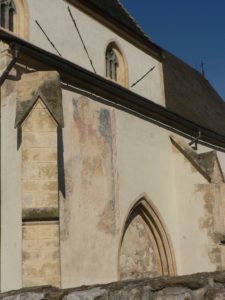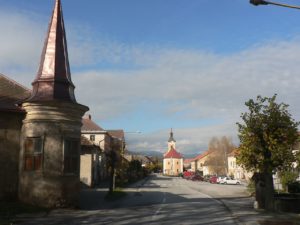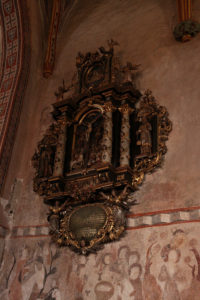Csetnek

Csetnek (Štítnik) is located in the Upper lands/Horná Zem/Felvidék, it is in Slovakia. It is 13 km from Rozsnyó (Roznava) to the west. Csetnek is worth visiting for its churches and old castle.
Here is a short video about it: https://www.youtube.com/watch?v=CJ1tJCwbeJ4

The small town was first mentioned in the document of King Béla IV in 1243 as Chitnek. The king gave the place to the son of Bebek Mátyás, namely to Szár Detre and Fülöp of the Ákos Clan. The king awarded the huge domain of Pelsőc to them, along with the lands in the Valley of the Sajó River that included the village of Berzéte. They received Lice in the Murány Valley as well as Kövi village in the Turóc Valley. This area was covered by large forests in the northern part of Gömör County.

In fact, the settlement of Csetnek was the northernmost place of the county, initially, there were just ten villages in the hand of the landlord. Within two generations, the Ákos Clan managed to establish 19 more villages, they invited many Saxons, too. Csetnek became a small Saxon mining town and began to flourish due to the rich iron ore that was found in the hills. The place was also called Chytnuk (1258) and Csethnik (1291) or Olchytnuk in 1330. The men of the mighty oligarch, Csák máté occupied Gömör County in 1306. The local lords either fled to the new king, Károly Róbert or joined Csák Máté’s army. The king could get this area only in 1320, though. It was the year when the town was granted the right to collect taxes and hold a market.

In 1320, János of the Ákos Clan was released from Csák Máté’s captivity and returned home. We have the document that shares the domains between the members of the Ákos Clan. It says that the land of Csetnek was owned by four members of the Clan: Kun Miklós, László, János, and Péter. The script doesn’t mention the existence of a castle. King Róbert Károly gave further privileges to it in 1328: Pelsőc and Csetnek received the same rights that the town of Korpona enjoyed. We know, that the Bebek branch of the family lived in Pelsőc while the Csetneki line lived in Csetnek. Csetnek was granted to continue holding weekly markets each Saturday.

Csetnek was a typical mining town, the sources of 1344 mention that they had used water energy for mining iron ore. The town was famous for its good-quality iron and copper. Italian painters arrived in Csetnek around 1350 and worked in the churches of Csetnek and Pelsőc. The first picture of a so-called “heavy plow” in Hungary was painted on the wall of the church of Csetnek around 1400. The Parish church was mentioned in 1355 and it has nice Gothic frescoes all over it.

The church was rebuilt in 1460 but its northern part has never been finished. The Evangelic church was built before 1286 and enlarged in the 14th century. It has the oldest built organ in Northern Hungary, it was made in 1484 and all its accessories are from the Renaissance age. The frescoes are painted by Italian Renaissance artists while the painting of the altar was made by Hans Aachens. The Pauline (Pálos) Order had its monastery next to the church and its ruins were still visible in the 19th century.

In 1426, we know that the Csetneki family sued the Bebek family who allegedly had many “Wlach” shepherds settled into a village of Irnes, right in the forest of Csetnek. They had caused damage with their animals that was 3 thousand pieces of gold, clearly an impossible sum. There were 67 houses in 1427 which paid taxes. We have a document from 1432 in which King Zsigmond allowed the Csetneki family to build a fortification. However, the castle had been built before, in the 13th century but it became more important in the Turkish age.
We have a document from 1448 that mentions the Guild of the Smith craftsmen who lived in the agricultural town of Csetnek. Life was not always peaceful: in 1469, a noble family who lived in Csetnek, took away the inhabitants’ horses, iron, planks, and woven cloths by force and they had the animals of the nearby village of Rochfalva herded to Murány castle. At the same time, the Csetneki family destroyed a peasant house in Lukafalva, then they even plowed its place. Later, a huge plague killed many of the inhabitants in 1555.

During the bloody Dual Kingship of Hungary, Habsburg Ferdinand occupied this area in 1556 and he confiscated the lands of Csetneki László (the town of Csetnek and Dobsina) because he had supported King Szapolyai. Right after this, the Horváth and the Bakos families gained the domains of Csetnek castle. The first Ottoman raid hit the area in 1561. The Turks plundered the Valley of Csetnek, including the settlement of Restér and the smaller villages as well. In answer to the growing threat, the castle was reinforced between 1580 and 1585, and bastions were needed to hold cannons. However, Csetnek never had an important military role, it always depended on the stronger castles’ of the area.
According to a legend, the castle and the Gothic church were connected by an underground tunnel. The latest archeological excavations have found the remains of this tunnel which had led indeed to the “vizivár” to the “water castle”, as it was called at that time because the palisade walls reached into the small river.

The smiths of the town wrought very good quality swords and it was why the Turks didn’t burn the town: the inhabitants paid their taxes to the Turks by making them splendid blades every year. The crescent moon can be seen on the tower of the church instead of the cross, as a memento of those times.

These settlements were too close to the borderline and many times they had to pay taxes to both the Muslims and the Christians. Now you can see two blades hanging on the wall of the city hall: one of them is a saber they had wrought for the kuruc soldiers of Prince Rákóczi Ferenc while the other one is the great sword of the town’s executioner.

The owners of the castle have changed each other quite frequently after the Horváth and the Bakos, the Andrássy and the Thököly and the Rokfalussy families were its owners. Finally, the Andrássy family and the Szontagh family were its owners. You can see three stately homes of these families in the town which is a village now.
According to an inventory in 1610, there were many books stored in the castle, and there was a nicely kept kitchen garden in 1636. We know, that the servants prepared a room for the visit of Prince Rákóczi György I of Transylvania in 1643 but we do not know whether he went there or not.

The castle was later rebuilt as a fortified palace at the beginning of the 17th century. It was a four-story building in 1664 and the Royal Treasury inherited it in 1666. We know, that there was at least one cannon in the castle and three hook guns in 1683. Later, the rebel Kuruc troops put it on fire in 1685, and the castle became uninhabitable. Prince Rákóczi Ferenc used to own another stately home in the town in 1694. However, there were a few intact buildings in 1711.
In Csetnek, the plague had many victims in 1710 and in 1739, too. The small town kept its traditions until the 19th century, namely, that the judge of the town had silver coins spread to the poor every New Year’s Eve. Around 1900, the new owner became Sárkány Gyula, a well-known painter of his age. He was the one who had the castle restored. In our days, many parts of Csetnek castle are intact while other parts are quite ruined.

Dear Readers, I can only make this content available through small donations or by selling my books or T-shirts:
Please, feel free to support me with a coffee here:
You can check out my books "33 Castles, Battles, Legends" and "The Ring of Kékkő Castle" on Amazon or Draft2Digital, they are available in hardcover, paperback, or ebook: https://www.amazon.com/dp/198020490X or at https://books2read.com/b/boYd81
 My work can also be followed and supported on Patreon: Become a Patron!http://Become a Patron!
My work can also be followed and supported on Patreon: Become a Patron!http://Become a Patron!


https://hungarianottomanwars.myspreadshop.com/all



